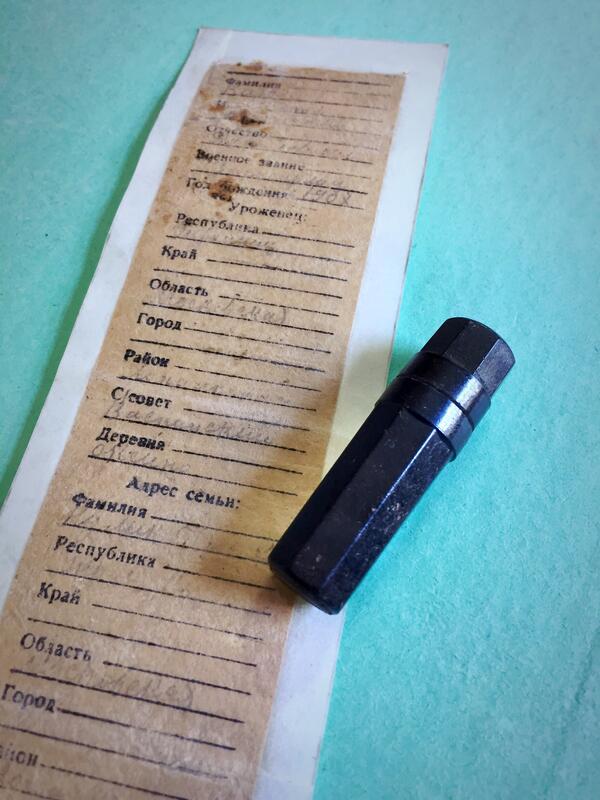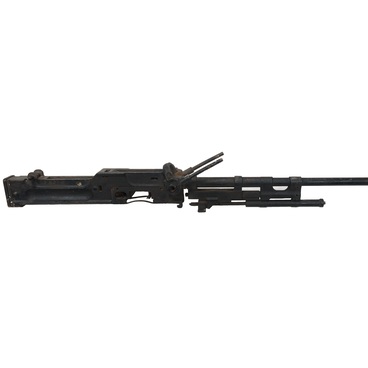The death medallion in the Red Army was introduced by Order No. 856 of the Revolutionary Military Council from August 14, 1925. It was part of supplied equipment and in case of loss was replaced with a new one. The medallion was a rectangular case made of galvanized tin with an eye for a cord. Inside there was an insert made of paper (parchment or newsprint) — a form with the soldier’s personal information. Such a medallion was not sealed, and therefore the insert quickly became damaged.
The People’s Commissariat of Defense of the USSR by Order No. 138 from March 15, 1941 adopted the “Decree on personal accounting of losses and burials of the deceased Red Army personnel in wartime”. With it, new medallions in the form of a black ebonite (textolite) pencil case were introduced; they held an insert on parchment paper in two copies. The 40 by 180 mm insert consisted of two identical forms, one of which was to be withdrawn by the team that conducted the burial, and the other was to remain in the medallion with the body of the deceased fighter. The insert, intended for servicemen of the border guards’ units of the NKVD troops, had a slightly larger size — 53 by 280 mm — and a vertical green 5-millimeter-wide stripe along its entire length. The inserts removed from the medallions were used to establish the names of the dead and of those who remained on the battlefield, and to compile lists of losses. But in reality, in the difficult war conditions, this requirement was not fulfilled and the entire medallion was taken. In addition, Red Army soldiers were often given only one copy of the insert due to shortages. The form contained all the necessary information about the fighter. The medallion was quite airtight when closed with a tight twist. There was a special pocket on the waistband of the trousers, into which the capsule was sewn, as it was prescribed in the regulations.
Handmade medallions were most often made from a rifle cartridge plugged with an inverted bullet. Wooden and metal homemade pencil cases are sometimes found by archaeologists and search groups. The soldiers also used a wooden case from an anti-fog pencil, which was part of a gas mask bag. Notes in such medallions were usually also made by hand, although some had official forms in them.
In November 1942, by order No. 376 of the People’s Commissariat of Defense of the USSR “On the removal of medallions from the equipment of the Red Army”, the medallions were discontinued. Most likely, it was decided not to duplicate the information from the Red Army identification book, introduced in November 1941, and rely only on it.
The People’s Commissariat of Defense of the USSR by Order No. 138 from March 15, 1941 adopted the “Decree on personal accounting of losses and burials of the deceased Red Army personnel in wartime”. With it, new medallions in the form of a black ebonite (textolite) pencil case were introduced; they held an insert on parchment paper in two copies. The 40 by 180 mm insert consisted of two identical forms, one of which was to be withdrawn by the team that conducted the burial, and the other was to remain in the medallion with the body of the deceased fighter. The insert, intended for servicemen of the border guards’ units of the NKVD troops, had a slightly larger size — 53 by 280 mm — and a vertical green 5-millimeter-wide stripe along its entire length. The inserts removed from the medallions were used to establish the names of the dead and of those who remained on the battlefield, and to compile lists of losses. But in reality, in the difficult war conditions, this requirement was not fulfilled and the entire medallion was taken. In addition, Red Army soldiers were often given only one copy of the insert due to shortages. The form contained all the necessary information about the fighter. The medallion was quite airtight when closed with a tight twist. There was a special pocket on the waistband of the trousers, into which the capsule was sewn, as it was prescribed in the regulations.
Handmade medallions were most often made from a rifle cartridge plugged with an inverted bullet. Wooden and metal homemade pencil cases are sometimes found by archaeologists and search groups. The soldiers also used a wooden case from an anti-fog pencil, which was part of a gas mask bag. Notes in such medallions were usually also made by hand, although some had official forms in them.
In November 1942, by order No. 376 of the People’s Commissariat of Defense of the USSR “On the removal of medallions from the equipment of the Red Army”, the medallions were discontinued. Most likely, it was decided not to duplicate the information from the Red Army identification book, introduced in November 1941, and rely only on it.





